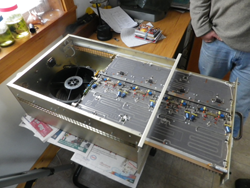Canadian hams attempt to cross The Pond on Two Metres
 A group of amateur radio operators from Atlantic Canada will operate from Pouch Cove, Newfoundland, from 4-12 July 2014 in a bid to complete a two metre transatlantic QSO and claim the Brendan Trophy.
A group of amateur radio operators from Atlantic Canada will operate from Pouch Cove, Newfoundland, from 4-12 July 2014 in a bid to complete a two metre transatlantic QSO and claim the Brendan Trophy.
The expedition will operate from Maidenhead Grid GN37os on 144.270 MHz. It will run 750 watts into a 30 metre long rope yagi with a gain of more than 23 dB over a dipole. The group will concentrate its efforts on JT65B, a digital mode that offers greatly enhanced performance over more conventional modes. It will have the capability to use other modes including CW and SSB if conditions warrant however. A special callsign has been requested and will be announced when approved. In the event that approval for a special callsign is not received, the group will use VO1NO.
 Members of the expedition include Fred Archibald, VE1FA, Roger Sturtevant, VE1SKY, Helen Archibald VA1YL, Rich Pieniaszek, VA1CHP, and Al Penney, VO1NO. The Brendan Trophy is a series of awards offered by the Irish Radio Transmitters Society to the first amateur radio operators to complete a two metre transatlantic QSO.
Members of the expedition include Fred Archibald, VE1FA, Roger Sturtevant, VE1SKY, Helen Archibald VA1YL, Rich Pieniaszek, VA1CHP, and Al Penney, VO1NO. The Brendan Trophy is a series of awards offered by the Irish Radio Transmitters Society to the first amateur radio operators to complete a two metre transatlantic QSO.
Details and daily updates on the expedition can be found on the team’s website www.brendanquest.org. Real time information on operating modes and schedules will be posted during the expedition on the team’s website, the ON4KST site and the G4CQM Shoutbox. Facebook users are also welcome to join the group’s page Brendan Quest 2M metre Transatlantic Attempt 2014.
Background Information:
2014 Transatlantic Two metre “Brendan Quest” Objectives:
1. Complete one or more legal, confirmed, two-way QSOs between North America and Europe on the amateur radio two metre band using terrestrial propagation modes;
2. Complete such contacts using both “traditional” (CW or SSB) and “non-traditional”
(JT65B or ISCAT) modes; and;
3. Failing the above, to be heard in Europe.
Operators (North America):
Fred Archibald VE1FA; Helen Archibald VA1YL; Al Penney VO1NO; Rich Pieniaczek VA1CHP; Roger Sturtevant VE1SKY.
Operation: 4 to 12 July 2014.
Call: A special callsign has been requested. In the event one is not issued, the group will use VO1NO.
Frequency and Modes: 144.270 MHz +/- 20 Hz operating 24 hours a day for the entire period, transmitting full legal power on even minutes and receiving on odd minutes using JT65B. Other modes may be attempted as required. Audible transatlantic JT65B reception and QSO will be followed by a CW attempt.
North America QTH: Pouch Cove, Newfoundland, Canada. Latitude 47.76942° North, Longitude 52.76384° West
Elevation: 65 feet (20 metres) above sea level.
Grid Square: GN37os.
IOTA island: NA-027.
Antenna height is 85 feet (26 metres) above sea level on a bluff on the edge of the Atlantic. There is no land between the transmit location and Europe through bearing range of 013 to 108 degrees True. The transmit location is 3040 km from Irish coast, 3400 km from Poldhu, and 23 km from Marconi’s 1901 reception site.
Antenna: Horizontally polarized “rope ladder” Yagi, with 43 elements consisting of one reflector, one driven element and 41 directors, suspended and aligned on two strands of Kevlar rope 65 cm apart. Its overall length is 30 metres. Because the ground slopes towards the ocean, the height of the antenna varies from six metres above ground at the reflector, to 8.5 metres at the opposite end. Its feedpoint impedance is 50 ohms, and it will employ a ferrite choke balun. The SWR is 1.1 to 1.2. Forward gain is 23.9 dB over a dipole. The front to back ratio is 32 db, while the front to side ratio is greater than 25 db (270°). The takeoff angle of the main lobe is 4.5°. The beamwidth is 15.6° at the -3db points, and beam thickness is 4.7° at the -3db points. When driven with 750W, the Effective Radiated Power in the center of the major lobe should be about 150kW.
Antenna coverage in Europe at -3db points: Based on an antenna azimuth of 062° True and a beamwidth of 15.8° at the -3db points, the antenna beam width will be 069° to 054° True, so straight line propagation will cover all Ireland, UK, and parts of Norway, France, and Holland. Of course propagation paths may be skewed.
Further information
- www.brendanquest.org
- info@brendanquest.org
Category: RSGB Notices











